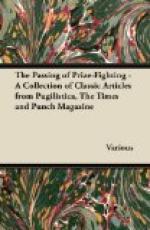Spurred to emulation by this striking example of journalistic enterprise, correspondents in all parts of the world are composing piquant descriptions of similar contracts. We offer two examples:—
1. Miss Fanny V. Adie consented to give the correspondent of The Poppleton Observer a few particulars of her engagement to Captain Scorcher, O.B.E.:—
“I was sitting on my ambulance having a biscuit and tin of bully with Alphonse (my French poodle), when suddenly there was a terrific crash. It appears, as I learnt later, that Captain Scorcher was motoring to Lille to purchase whisky and other medical comforts, when the steering-gear of his 60-H.P. Rolls-Ford came away in his hands, with the result that he nose-dived into the rear of my ambulance at forty miles per hour. When I came to my senses my head was in the ditch and the rest of me in mid-air. Captain Scorcher, crawling out of the wreckage, said, ‘Do you reverse?’ and then asked me to be his wife. I said ‘Yes,’ meaning I reversed, and the marriage takes place as soon as we arrive at the same hospital. We have been more or less bosom-friends for five minutes, and I think his moustache is the sweetest thing I ever met.”
2. Asked if she could confirm her reported engagement to Lord Bertie Brasshatte, Miss Fifi Thistledowne—who dances “The Camisole Squeeze” so daintily in “Really, Girls!” (the Mausoleum revue)—recounted to the correspondent of The Jazzers’ Gazette the following romantic story:—
“I was having oysters and stout with my chiropodist at his place in Stepney, and among the people there was Lord Bertie Brasshatte, who is a martyr to cold feet, contracted during his visit to Boulogne in 1918. (How can we ever repay these brave men for the hardships they have suffered?) Well, after the tenth oyster he passed me two slips of buff paper, pinned together. On the first was written, ’For information and necessary action, please;’ and on the other, ’Are you engaged tomorrow?’ I said, ‘No,’ and the marriage takes place as soon as my agent can make arrangements with the illustrated papers. We’ve been friends ever since Lord Bertie left a lovely diamond tiara in my waste-paper basket, and I think his suppers are the finest I have ever tasted.”
* * * * *
HIMALAYANS AT PLAY.
(Suggested by the sequel to a recent Lecture.)
The Chairman, Sir Norman Everest, after congratulating the lecturer on his interesting address and beautiful photographs, observed that he remained unconvinced by his arguments in favour of approaching Mount Amaranth from the North. The climatic difficulties of that route were in his opinion insuperable, to say nothing of the hostility of the natives of the Ong-Kor plateau and the Muzbakh valley. He still believed that the best mode of approach was from the South-West, following the course of the Sissoo river to Todikat, where an ample supply of yaks could be obtained, and thence proceeding along the Dagyolong ridge to Tumlong.




